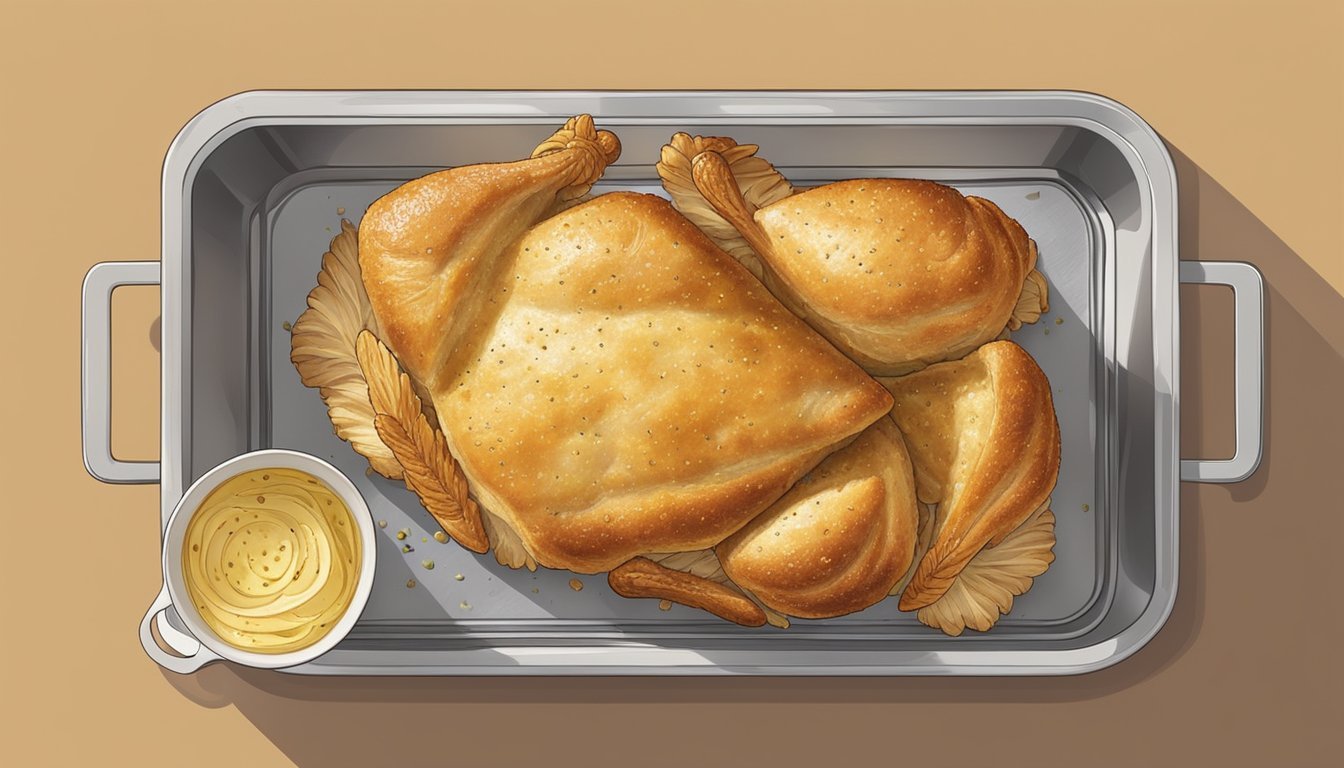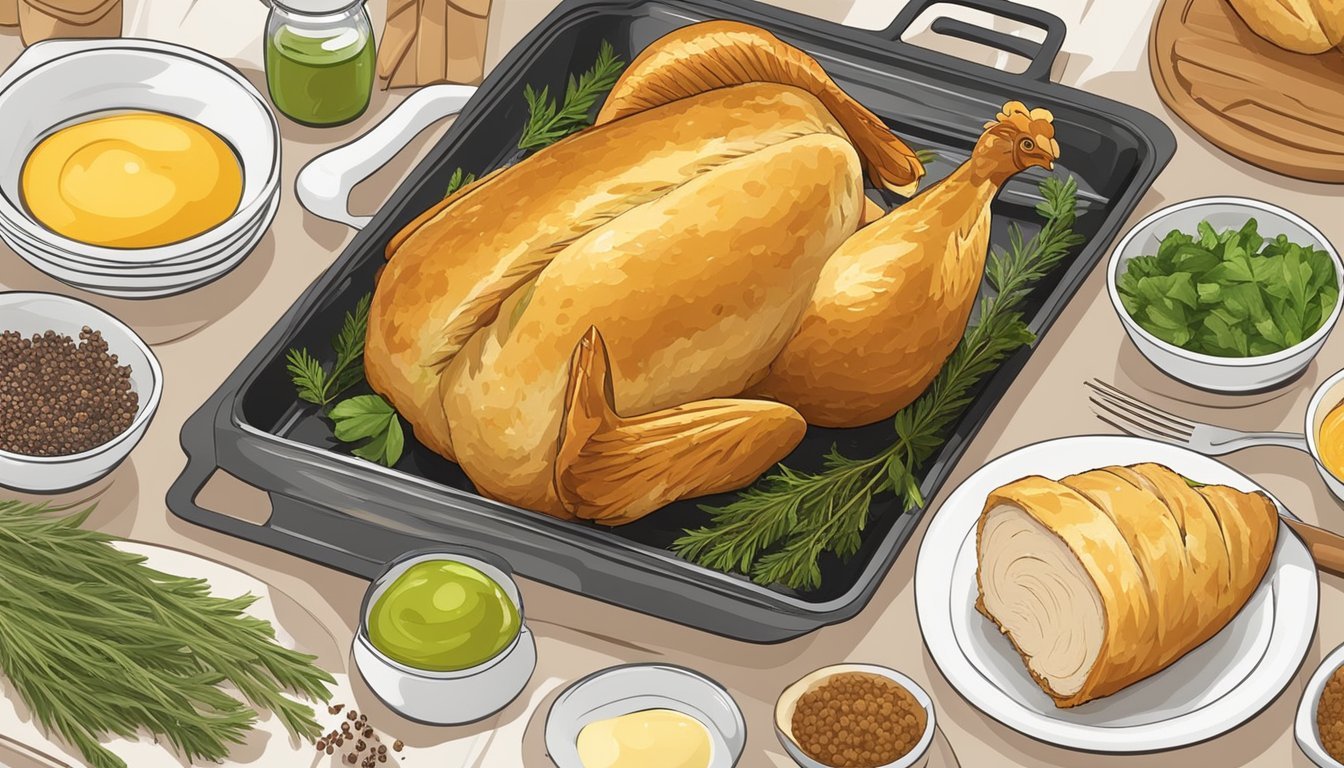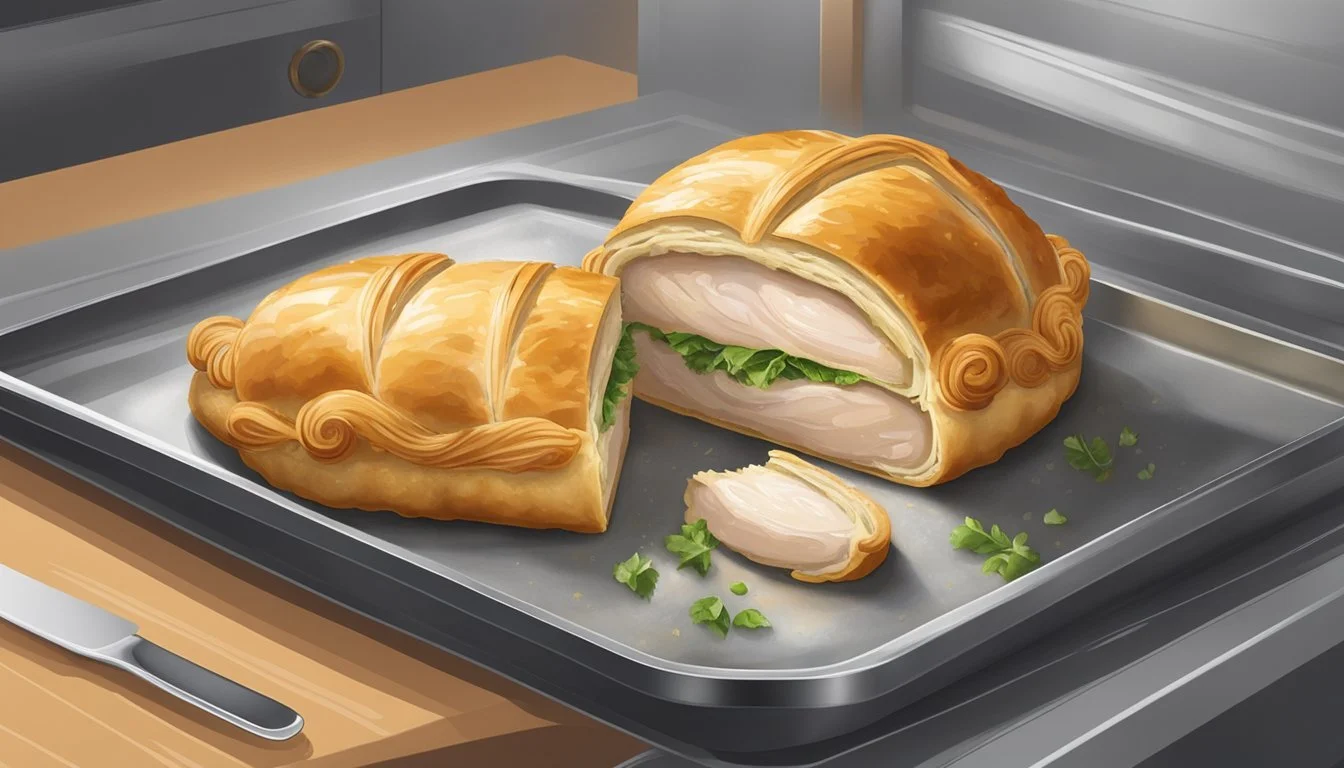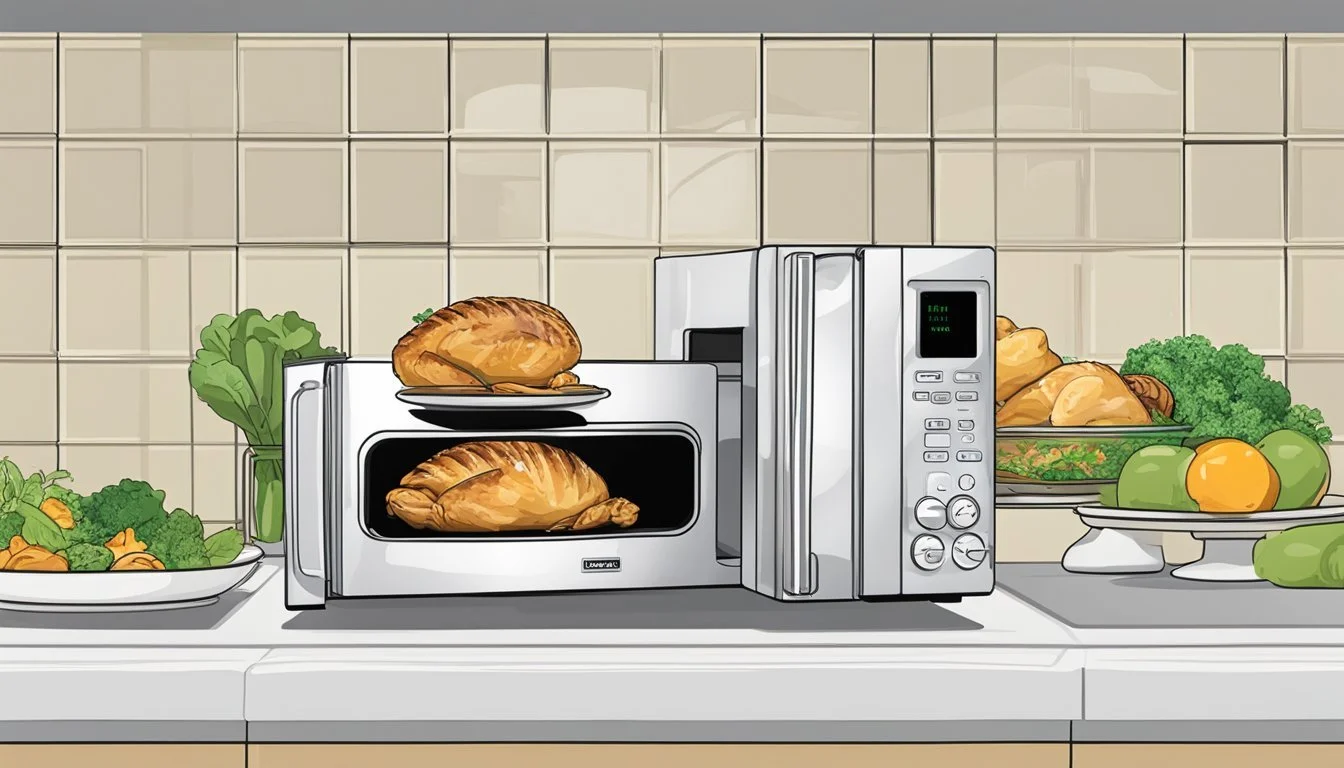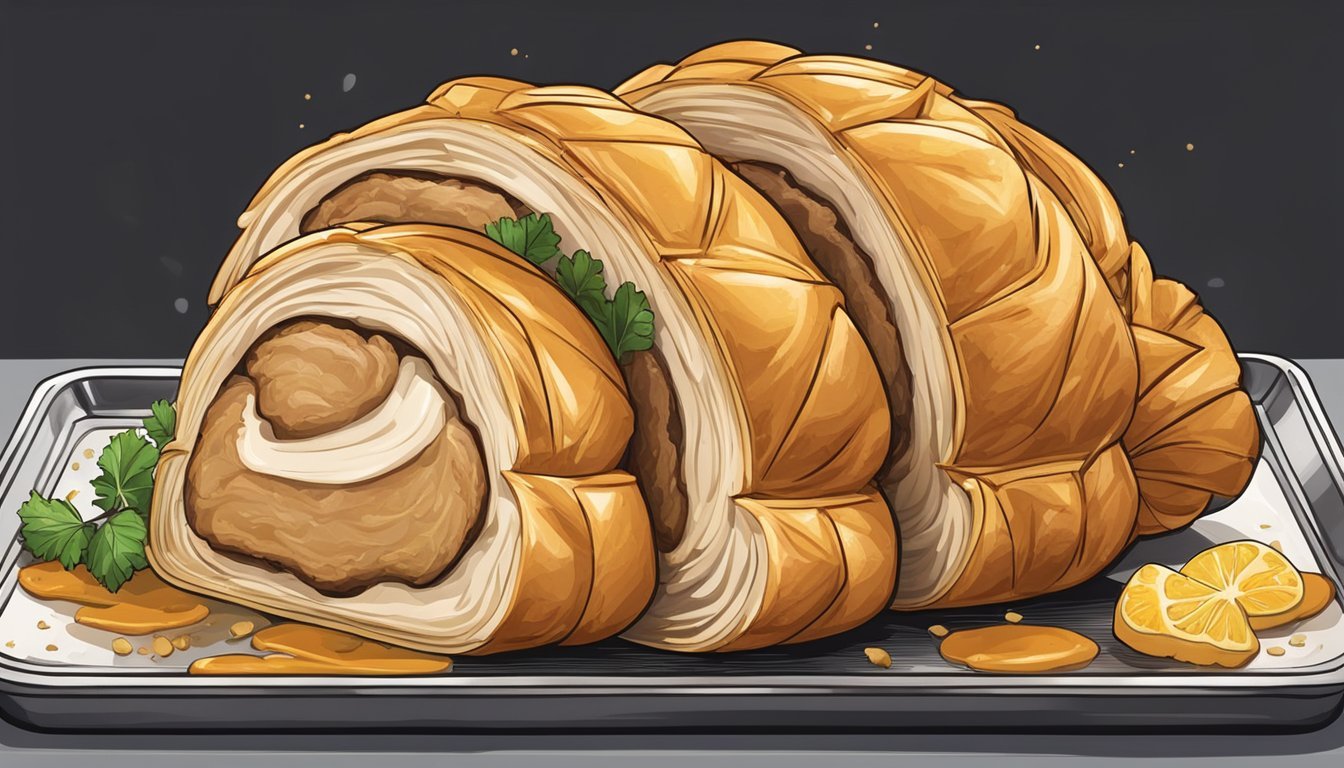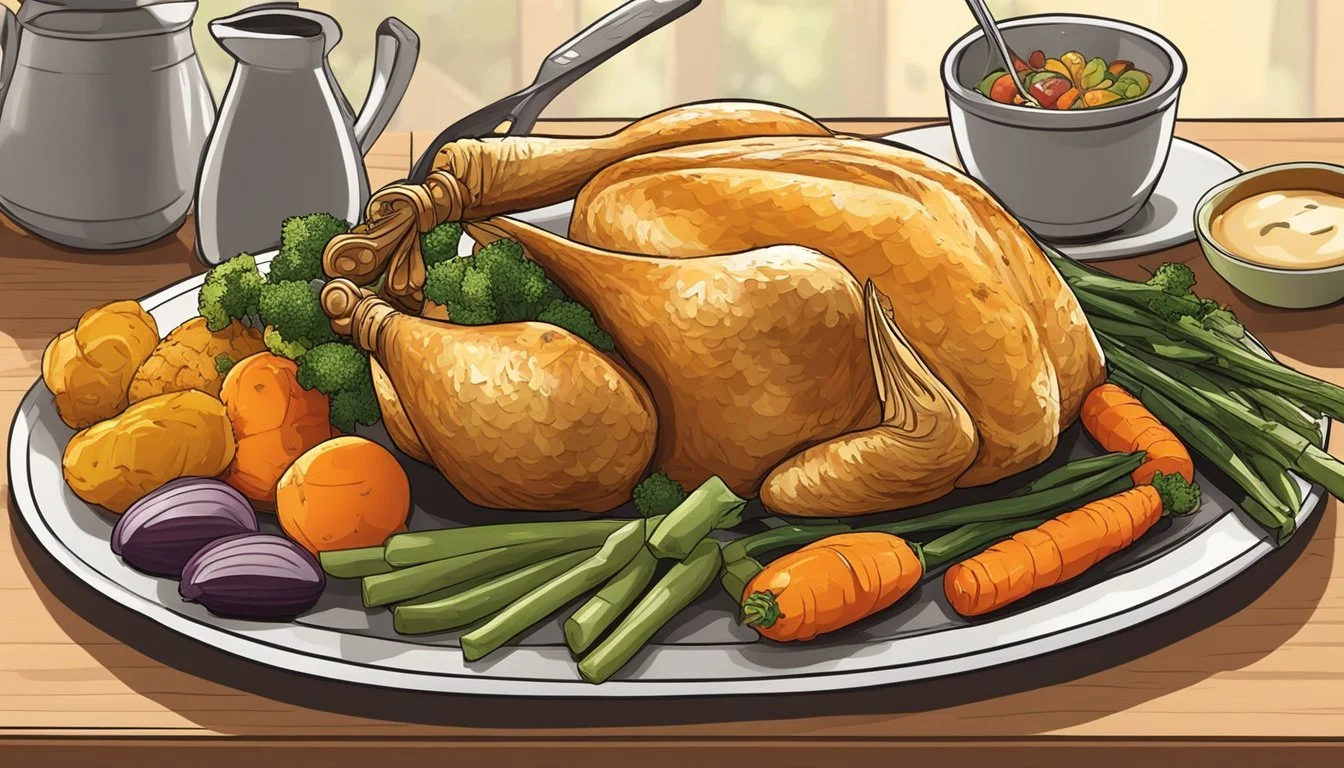Best Way to Reheat Chicken Wellington
Tips for Maintaining Flaky Pastry and Tender Fillings
Reheating Chicken Wellington poses a unique challenge as it requires preserving both the juiciness of the chicken and the flakiness of the pastry. The best method for reheating should carefully balance heat distribution to prevent drying out the meat, while also ensuring that the pastry retains its desirable texture.
One of the chief concerns when reheating Chicken Wellington is the retention of moisture and flavor within the chicken. To achieve this, a gentle reheating process is necessary, avoiding high temperatures that can cause the meat to become tough and lose its juiciness. Meanwhile, maintaining the flakiness of the pastry requires a dry heat that can crisp the outside without making it soggy or overly browned.
Understanding Chicken Wellington
Chicken Wellington is a refined dish that requires precise preparation and reheating to maintain its signature flakiness and juiciness. This section will dissect the dish’s key components and explain why the method of reheating is crucial to its integrity.
Components and Structure
Chicken Wellington is composed of several layers that contribute to its complexity and appeal. It typically consists of:
Tender chicken: It’s the centerpiece of the dish and is often seasoned with herbs such as thyme and black pepper for flavor.
Rich duxelles: A finely chopped mixture of mushrooms, shallots, garlic, and butter that provides a moist layer encasing the chicken.
Puff pastry: This forms the outer shell, known for its buttery, flaky quality.
Structural integrity of Chicken Wellington is paramount to its enjoyment. The puff pastry should be golden and crispy, and the chicken must remain moist. Any variation in this structure could lead to a dish that does not embody the classic Chicken Wellington experience.
Importance of Reheating Method
Reheating Chicken Wellington is not just a matter of warming it up; it requires a technique that preserves the moisture of the chicken while maintaining the flakiness of the pastry.
An inappropriate reheating method can result in:
Soggy pastry: Losing the prized flakiness.
Dry chicken: Sacrificing the main feature of a tender, juicy interior.
The optimal approach should evenly distribute heat without drying out the chicken or softening the pastry. Techniques such as using a low oven heat or reheating gently in a skillet can contribute significantly to restoring the dish's freshly-cooked integrity, especially when reheating leftover chicken.
Pre-Reheating Preparation
Preparing Chicken Wellington for reheating involves crucial steps to ensure that its flakiness and juiciness are retained. Thorough defrosting and temperature acclimatization are key to avoid thermal shock and ensure an even reheat.
Thawing Frozen Chicken Wellington
If the Chicken Wellington is frozen, it should be properly thawed before reheating. Here's the correct method to defrost it:
Transfer the Chicken Wellington from the freezer to the refrigerator.
Allow it to defrost slowly, typically taking 24 hours for a standard-sized Wellington.
This process ensures that the chicken remains at a safe temperature during thawing, preventing the growth of harmful bacteria.
Bringing to Room Temperature
Before reheating, the Chicken Wellington should be brought to room temperature. The steps are as follows:
Remove the Chicken Wellington from the refrigerator.
Let it sit on the countertop for about 20 to 30 minutes.
This step allows the chicken to reach a more uniform temperature, which promotes even reheating and preserves its succulence and the pastry’s flakiness when it's placed in the oven.
Oven Reheating Method
When reheating Chicken Wellington in the oven, one must maintain its flakiness while ensuring the chicken stays juicy. This section will guide readers through properly setting up the oven, the reheating process, and checking the internal temperature of the chicken.
Setting Up the Oven
To begin, it is crucial to preheat the oven to 350°F (175°C), creating a stable heating environment. Place a wire rack on a baking sheet, which will allow heat to circulate around the Chicken Wellington, promoting even reheating and maintaining the pastry's flakiness.
Reheating Process
Once the oven is preheated, wrap the Chicken Wellington in aluminum foil. This helps retain moisture, preventing the chicken from drying out and the pastry from burning. Place the wrapped Chicken Wellington on the prepared wire rack and baking sheet setup. The foil should be loose to ensure heat can circulate inside.
Checking Internal Temperature
The Chicken Wellington should be reheated until it reaches an internal temperature of 165°F (74°C), which can be measured using an instant-read thermometer. Insert the thermometer into the thickest part of the chicken for an accurate reading. This step is critical to ensure food safety and optimal juiciness.
Alternative Reheating Methods
When reheating Chicken Wellington, maintaining the flakiness of the pastry and the juiciness of the chicken is paramount. The key is to apply gentle heat and protect the dish's integrity.
Stovetop Method
To effectively use the stovetop for reheating, they need a skillet and a small amount of water or stock to prevent dryness. They should:
Heat the skillet on medium with just enough liquid to coat the bottom.
Place the Chicken Wellington in the skillet, cover with a lid, and warm gently, checking periodically until heated to the appropriate temperature.
Air Fryer Method
The air fryer offers a quick and effective way to reheat while maintaining the pastry's crispness. Here’s how they can do it:
Preheat the air fryer to 300°F (150°C).
Place the Chicken Wellington in the air fryer basket, ensuring it's not overcrowded.
Heat for about 8-10 minutes, or until the interior registers 165°F (74°C).
Microwave Method
If time is of the essence, the microwave can be used, though it may slightly affect texture. They must:
Place the Chicken Wellington on a microwave-safe plate.
Cover it with a damp paper towel to encourage moisture retention.
Use a medium power setting, heating in short intervals of 30 seconds, checking the warmth between intervals to avoid overheating.
Maintaining Moisture and Crunch
To ensure Chicken Wellington retains its moist center and crispy exterior during reheating, one must use careful techniques that involve both moisture control and physical barriers.
Utilizing Liquids
When reheating, maintaining the moisture of the chicken filling is crucial. One effective method is to gently brush the chicken with olive oil or chicken broth. This not only helps to keep the meat moist but can also add flavor.
Chicken: Brush lightly with olive oil.
Chicken Broth: Alternatively, a tablespoon of chicken broth can provide moisture without fat.
Foil and Parchment Paper
To protect the flaky pastry during reheating, and to prevent the pastry from becoming soggy from the chicken's moisture, it's important to use foil and parchment paper strategically.
Foil: Cover the Chicken Wellington loosely with foil during the initial reheating to retain moisture without sacrificing crispness.
Parchment Paper: Using parchment paper between the chicken and the foil can prevent sticking and help in even heat distribution.
Safety and Storage Considerations
Ensuring the safety and quality of Chicken Wellington when reheating and storing is crucial. Proper temperature control and storage methods are key to preventing bacterial growth and preserving the dish's flavors and textures.
Safe Reheating Temperatures
To safely reheat leftovers, it is essential to reach an internal temperature that eliminates harmful bacteria. Chicken Wellington should be reheated to a safe temperature of 165°F. Use a food thermometer to check the center of the Wellington, ensuring it is thoroughly heated.
Storing Leftovers
Leftover Chicken Wellington should be stored in the refrigerator within two hours of cooking to minimize the risk of bacterial growth. Wrap the leftovers tightly in plastic wrap or aluminum foil, or place them in an airtight container to maintain moisture and extend shelf life. Properly stored, Chicken Wellington can be kept in the refrigerator for 3 to 4 days.
Preventing Bacterial Growth
To extend the life of your Chicken Wellington beyond a few days, freezing is an effective option. When freezing, wrap the Wellington securely in plastic wrap, followed by a layer of foil, to prevent freezer burn. The key to preventing bacterial growth is to keep leftovers at a consistent temperature, either below 40°F in the refrigerator or at 0°F in the freezer for longer storage. Defrost frozen Chicken Wellington in the refrigerator overnight before reheating to ensure even warming and food safety.
Final Tips for Best Results
To reheat Chicken Wellington effectively, one has to strike the right balance between retaining the moisture of the chicken and preserving the pastry's crispness. These final tips hone in on crucial aspects to avoid mishaps and enhance the dining experience.
Avoiding Common Mistakes
Overcooking: Strictly adhere to reheating times to prevent drying out the chicken. It should reach an internal temperature of 165°F, no more, to ensure it remains tender.
Reheating method: Use an oven or air fryer set at a moderate temperature to warm the wellington evenly without compromising the flakiness of the pastry.
Moisture preservation: Add a small amount of liquid—water or chicken broth—when reheating, but be careful to keep the pastry from becoming soggy.
Enhancing Flavor After Reheating
Seasonings: After reheating, one might find that seasonings have mellowed. Gently brush the Chicken Wellington with a sauce that complements its flavors to rejuvenate its zest.
Sauce: Consider serving with a side of sauce that not only adds moisture but also enriches the overall flavor profile of the Chicken Wellington.
Each step is geared towards delivering a reheated Chicken Wellington that's as close to freshly baked as possible — flaky on the outside, moist and flavorful on the inside.
Serving and Pairing Suggestions
Chicken Wellington is best enjoyed with sides and pairings that complement its rich flavors without overpowering the dish. Careful selection ensures a harmonious dining experience.
Side Dishes
Elevating Chicken Wellington involves pairing it with sides that balance the dish's texture and taste.
Roasted Vegetables: They offer a caramelized edge that contrasts the flakiness of the Wellington.
Garlic Mashed Potatoes: Their creamy texture pairs well with the crisp pastry.
Fresh Salad: A light, vinaigrette-dressed salad cuts through the richness and cleanses the palate.
Wine Pairings
Selecting the right wine can bring out the nuanced flavors of Chicken Wellington.
Chardonnay: A full-bodied white wine complements the chicken and pastry without dominating the flavor.
Pinot Noir: This red wine's subtle earthy tones pair well with the mushroom duxelles typically found in Chicken Wellington.

